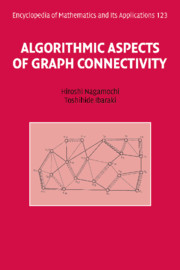Book contents
- Frontmatter
- Contents
- Preface
- Notation
- 1 Introduction
- 2 Maximum Adjacency Ordering and Forest Decompositions
- 3 Minimum Cuts
- 4 Cut Enumeration
- 5 Cactus Representations
- 6 Extreme Vertex Sets
- 7 Edge Splitting
- 8 Connectivity Augmentation
- 9 Source Location Problems
- 10 Submodular and Posimodular Set Functions
- Bibliography
- Index
2 - Maximum Adjacency Ordering and Forest Decompositions
Published online by Cambridge University Press: 07 May 2010
- Frontmatter
- Contents
- Preface
- Notation
- 1 Introduction
- 2 Maximum Adjacency Ordering and Forest Decompositions
- 3 Minimum Cuts
- 4 Cut Enumeration
- 5 Cactus Representations
- 6 Extreme Vertex Sets
- 7 Edge Splitting
- 8 Connectivity Augmentation
- 9 Source Location Problems
- 10 Submodular and Posimodular Set Functions
- Bibliography
- Index
Summary
In this chapter, we discuss how to decompose a given multigraph G into a set of forests to obtain a spanning subgraph that preserves the edge/vertex-connectivity of G. We introduce a total ordering of the vertices in a multigraph G, called a maximum adjacency (MA) ordering, and then find such a forest decomposition. Based on this set of forests, we can convert G into a sparse graph in linear time while preserving the edge/vertex-connectivity. This sparsification technique can be used for many connectivity algorithms as a preprocessing that reduces the size of input graphs. We describe some of the applications of connectivity algorithms.
Spanning Subgraphs Preserving Connectivity
A k-edge-connectivity certificate (resp. k-vertex-connectivity certificate) of a multigraph G is a spanning subgraph H of G such that, for any two vertices u, ν and any positive integer k′ ≤ k, there are k′ edge-disjoint (resp. internally vertex-disjoint) paths between u and ν in H if and only if there are k edgedisjoint (resp. internally vertex-disjoint) paths between u and ν in G. That is, a kedge- connectivity (resp. k-vertex-connectivity) certificate is defined as a spanning subgraph that preserves the edge-connectivity (resp. vertex-connectivity) up to k. Therefore,when H is a k-edge-connectivity certificate (resp. k-vertex-connectivity certificate) of G, H is k-edge-connected (resp. k-vertex-connected) if and only if G is k-edge-connected (resp. k-vertex-connected). If a k-edge-connectivity certificate H of G is k-edge-connected, then |ε(H)| ≥ holds since the degree of any vertex in H is at least k. Then we say that a k-edge-connectivity certificate H is sparse if |ε(H)| = O(kn). A sparse k-vertex-connectivity certificate is similarly defined. It is known that such a certificate exists [203].
- Type
- Chapter
- Information
- Algorithmic Aspects of Graph Connectivity , pp. 65 - 113Publisher: Cambridge University PressPrint publication year: 2008

